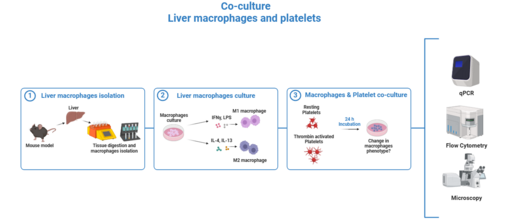3. Thema: Effect of blood platelets on liver macrophages
Supervisors:
Martina Casari
Centrum für Thrombose und Hämostase (CTH)
Dominik Siegl
Institut für Translationale Immunologie
Research Topic:
Hepatocellular carcinoma (HCC) ranks among the five most prevalent cancers worldwide and has only limited treatment options. Tumor-associated M2-type macrophages (TAMs) actively suppress an effective immune response to HCC. Platelets interact with macrophages to regulate their polarization and inflammatory responses in cancer and infection. We plan to characterize this interaction and aim at developing novel targeted therapeutics to effectively treat these conditions with combined macrophage repolarizing and platelet modulating interventions in vitro and in HCC mouse models in vivo. The effect and safety of these interventions will be assessed in liver infection models.
Background:
Our body deals with many different pathogens (e.g., bacteria, viruses) every day. Fortunately, we do not get sick whenever we come in contact with pathogens because we are equipped with a highly effective and complex immune system.
Our immune system plays a role not only in detecting and eliminating external threats but also in diseases developing within the body, such as autoimmune diseases, allergies, or cancer. In the first two examples, the immune system “overshoots”, tries to fight harmless substances (like pollen in an allergy), or attacks its own body. Cancer cells are often recognized and eliminated by the immune system at an early stage. If this is not the case, these cells can grow uncontrollably and form tumors. In this state, the immune system may eliminate some of the cancer cells but it is usually unable to eliminate the tumor, mainly because the tumor begins to interact with some immune cells and reprogram them for its benefit via signaling molecules, alteration of the tumor microenvironment (TME), and so on. One of these cell types in which we are particularly interested are macrophages.
The liver contains the biggest population of resident macrophages, called Kupffer cells, representing the first line of defense against pathogens and toxins that enter the liver through the bloodstream. Under physiologic conditions, these cells also play a critical role in regulating liver metabolism and maintaining liver homeostasis.
During liver disease, Kupffer cells are activated by different components and can change their phenotype (reprogramming), releasing an array of inflammatory mediators, growth factors and reactive oxygen species contributing to hepatocyte and liver injury. Understanding the role Kupffer cells play is key to clarify mechanisms of liver injury and potentially target and reprogram their phenotype.
Project:
During the project, you will learn how to isolate Kupffer cells from liver tissue and how to culture these murine macrophages.
You will isolate murine platelets and co-culture them with the Kupffer cells. The effect of the platelets on these macrophages will then be characterized using state-of-the-art methods such as flow cytometry, quantitative polymerase chain reaction (qPCR) and (fluorescence) microscopy.
As some of the supervisors speak English, very good English skills are required.
Source: Biorender
